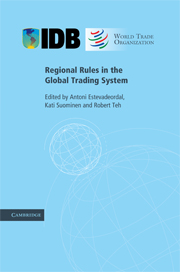Book contents
- Frontmatter
- Contents
- List of figures
- List of tables
- List of Contributors
- Foreword
- Acknowledgements
- List of abbreviations
- 1 Introduction
- 2 Big-Think Regionalism: a critical survey
- 3 Market access provisions in regional trade agreements
- 4 Trade remedy provisions in regional trade agreements
- 5 A mapping of regional rules on technical barriers to trade
- 6 Services liberalization in the new generation of preferential trade agreements: how much further than the GATS?
- 7 Mapping investment provisions in regional trade agreements: towards an international investment regime?
- 8 Competition provisions in regional trade agreements
- Appendix: List of RTAs included in the survey
- Index
5 - A mapping of regional rules on technical barriers to trade
Published online by Cambridge University Press: 01 March 2011
- Frontmatter
- Contents
- List of figures
- List of tables
- List of Contributors
- Foreword
- Acknowledgements
- List of abbreviations
- 1 Introduction
- 2 Big-Think Regionalism: a critical survey
- 3 Market access provisions in regional trade agreements
- 4 Trade remedy provisions in regional trade agreements
- 5 A mapping of regional rules on technical barriers to trade
- 6 Services liberalization in the new generation of preferential trade agreements: how much further than the GATS?
- 7 Mapping investment provisions in regional trade agreements: towards an international investment regime?
- 8 Competition provisions in regional trade agreements
- Appendix: List of RTAs included in the survey
- Index
Summary
Introduction
The progressive elimination of tariff barriers has shifted the attention to other forms of barriers to trade. In particular, the recent debate on market access issues highlighted technical barriers to trade (TBTs). These consist of standards, technical regulations and conformity assessment procedures. Standards and technical regulations specify the technical characteristics of a product or the conditions under which it is made. Product standards define the requirements of the characteristics of products (such as the level of safety of an electronic device), while production standards are the conditions under which a product must be made (such as the requirement of limited gas emissions). Conformity assessment procedures define the testing procedures necessary to assess the conformity of products to the norms.
Standards, technical regulations and conformity assessment procedures are not openly discriminatory against imports. The same standard may apply to domestically produced and imported goods. Yet they can act as a disguised form of protection. National standards may impose disproportionate costs on foreign producers. They may generate fixed costs from having to interpret the regulation and bring the product into conformity and might also raise marginal cost if the standard results in a decreased scale of operation. Similarly, conformity assessment procedures can also constitute a barrier to trade. Often exporters are requested to test and certify their products in each of the countries to which they export. These tests and certifications are costly, and duplication of tests exponentially increases costs.
- Type
- Chapter
- Information
- Regional Rules in the Global Trading System , pp. 250 - 315Publisher: Cambridge University PressPrint publication year: 2009
- 8
- Cited by

